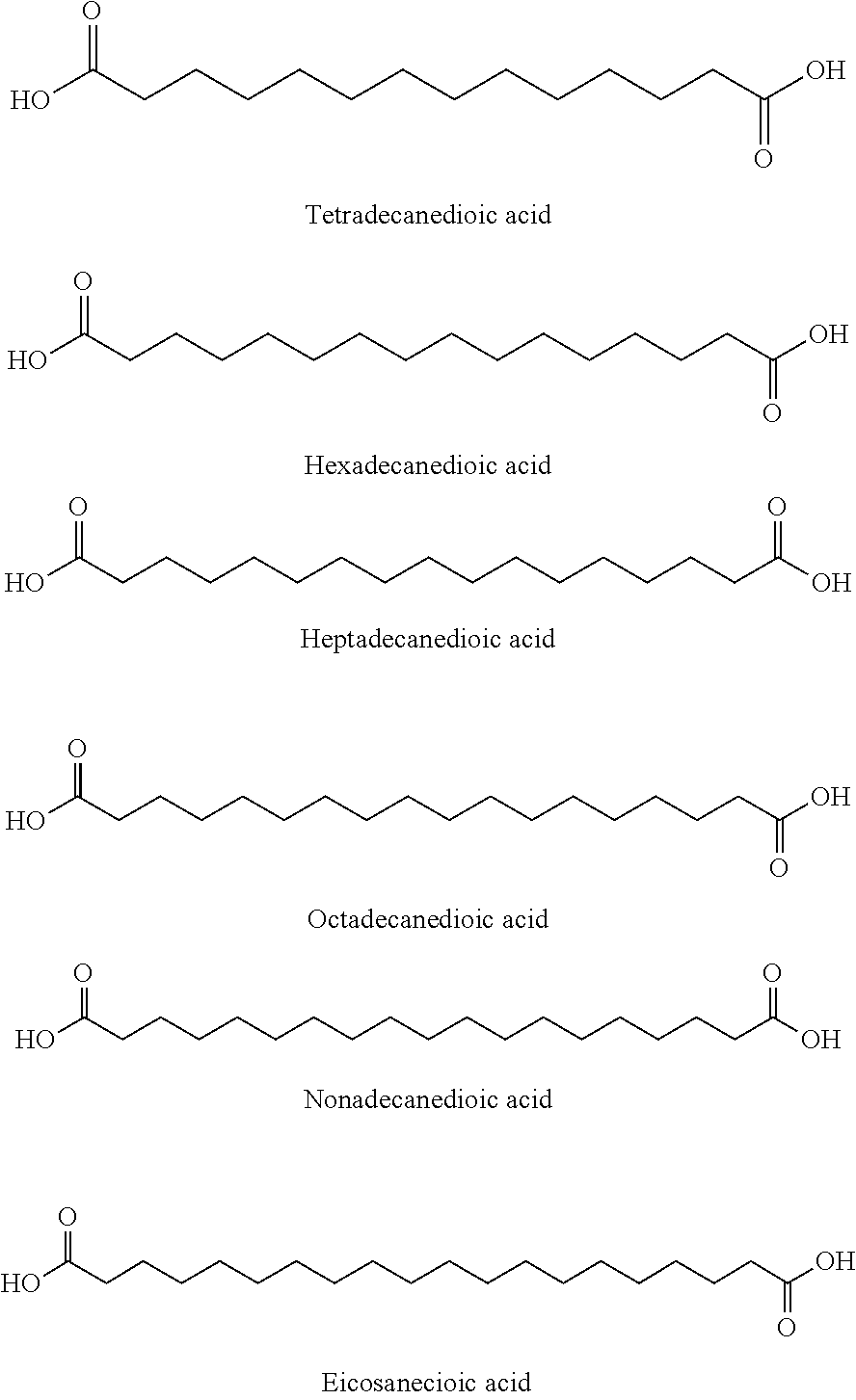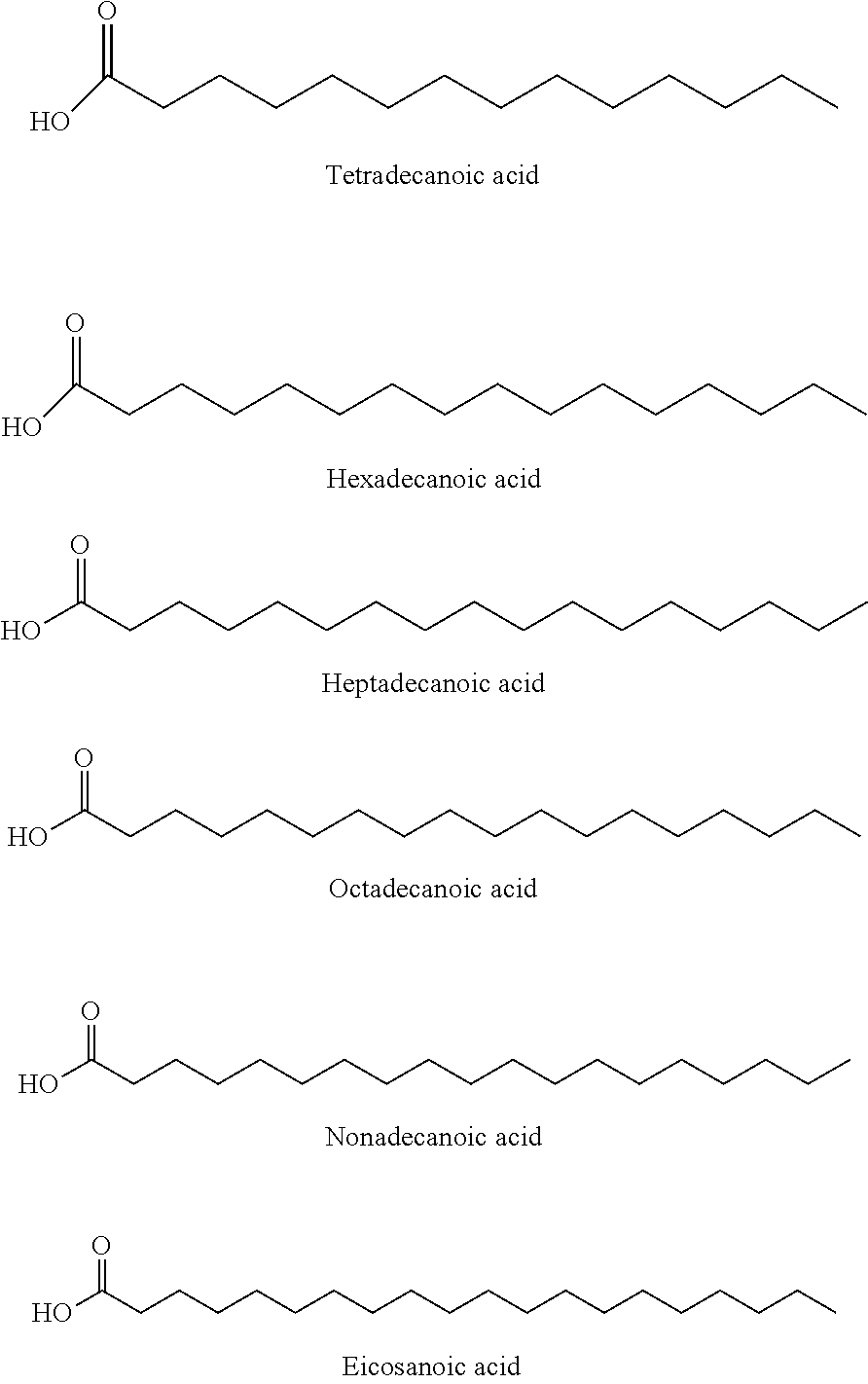Long-acting co-agonists of the glucagon and glp-1 receptors
a technology of glucagon and glp-1, which is applied in the direction of peptide/protein ingredients, drug compositions, metabolic disorders, etc., can solve the problems of complicated translation of human observations, and achieve the effects of preventing or reducing an increase in body weight, preventing or treating hyperglycemia, and preventing weight gain
- Summary
- Abstract
- Description
- Claims
- Application Information
AI Technical Summary
Benefits of technology
Problems solved by technology
Method used
Image
Examples
example 1
[0201]Peptides in Table 1 were synthesized by solid phase synthesis using Fmoc / t-Bu chemistry on a peptide multisynthesizer Symphony (Protein Technologies Inc.) on a 150 μmol scale, using either a Rink-amide PEG-PS resin (Champion, Biosearch Technologies, loading 0.28 mmol / g) or a Rink-amide PS resin (Chemlmpex loading 0.47 mmol / g).
[0202]All the amino acids were dissolved at a 0.3 M concentration in DMF. The amino acids were activated with equimolar amounts of HATU (O-(7-azabenzotriazol-1-yl)-N,N,N′,N′-tetramethyluronium hexafluorophosphate) solution 0.3 M in DMF, and a 2-fold molar excess of DIEA (N,N-diisopropylethylamine), solution 2M in NMP. The acylation reactions were performed in general for 1 hour with a 5-fold excess of activated amino acid over the resin free amino groups with double 45 minutes acylation reactions performed from His1 to Thr7 and from F22 to V23 and from D / E15 to Aib16 for sequences containing Aib16.
[0203]The side chain protecting groups were: tent-butyl fo...
example 2
[0215]Synthetic for peptide of sequence:
(SEQ ID NO: 110)HUQGTFTSDYSKYLDURAAQDFVK(PEG2PEG2γEC18-OH)WL2DT-NH2
legend: U=aminoisobutyric acid; 2=L-methionine sulphone; PEG2=8-amino-3,6-dioxaoctanoic acid; γE=γ-glutamic acid; C18-OH (Octadecanedioic acid)=—CO—(CH2)16-COOH; tBu=tert butyl; and fmoc=9-fluorenylmethyl chloroformate.
The peptide was synthesized by solid phase synthesis using Fmoc / t-Bu chemistry on a peptide multisynthesizer Symphony (Protein Technologies Inc.) on a 180 μmol scale, using a Rink-amide PS resin (Novabiochem, loading 0.35 mmol / g). All the amino acids were dissolved at a 0.3 M concentration in DMF (dimethyl formamide). The amino acids were activated with equimolar amounts of HATU (O-(7-azabenzotriazol-1-yl)-N,N,N′,N′-tetramethyluronium hexafluoro-phosphate) solution 0.3 M in DMF, and a 2-fold molar excess of DIEA (N,N-diisopropyl-ethylamine), solution 2M in NMP (N-methyl pyrrolidine). The acylation reactions were performed in general for 1 hour with a 5-fold exces...
example 3
[0218]Diet induced obesity (DIO) mice have long been used as surrogates for humans in the study of the efficacy of anti-obesity compounds. The results obtained from such mice in the study of obesity compounds are translatable to humans (See for example, Nilsson et al. Acta Pharmacologia Sinica 33: 173-181 (2012), which is incorporated herein by reference in its entirety). Thus, DIO mice are useful surrogates for humans for the testing the efficacy of compounds intended to treat obesity.
[0219]DIO mice are divided into groups of eight mice per group and the initial average body weight, food intake and basal glucose of each group were matched. Each group of mice is subcutaneously (sc) injected with a single dose of peptide or vehicle control. The administered doses may vary between 3 and 300 nmol / kg. Body weight and food intake are measured daily for four days after the initial dosing. Blood glucose is measured 5 hours post dose, and then daily for four days. A separate set of mice wer...
PUM
| Property | Measurement | Unit |
|---|---|---|
| Fraction | aaaaa | aaaaa |
| Molar density | aaaaa | aaaaa |
| Molar density | aaaaa | aaaaa |
Abstract
Description
Claims
Application Information
 Login to View More
Login to View More - R&D
- Intellectual Property
- Life Sciences
- Materials
- Tech Scout
- Unparalleled Data Quality
- Higher Quality Content
- 60% Fewer Hallucinations
Browse by: Latest US Patents, China's latest patents, Technical Efficacy Thesaurus, Application Domain, Technology Topic, Popular Technical Reports.
© 2025 PatSnap. All rights reserved.Legal|Privacy policy|Modern Slavery Act Transparency Statement|Sitemap|About US| Contact US: help@patsnap.com



